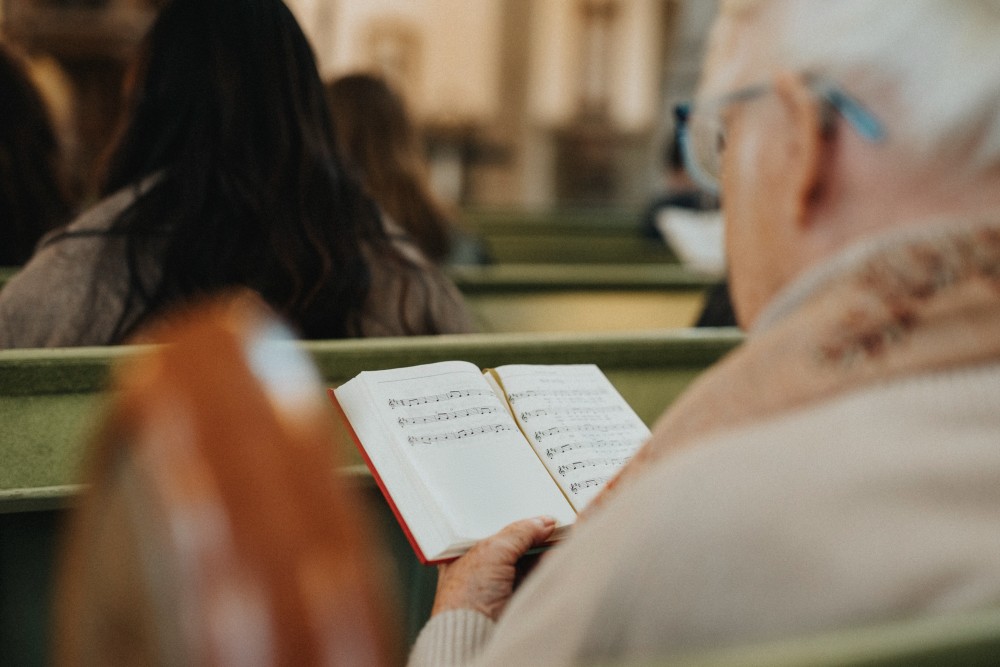
PROSPECT HEIGHTS — “Amazing grace, how sweet the sound, that saved a wretch like me …”
Most folks are familiar with that refrain and can sing along with their eyes closed. The same holds true for “Be Thou my vision, O Lord of my heart …”
The familiar sound of worship music that accompanies the Mass is exemplified in the beloved hymns that are heard during the service.
While all churchgoers are familiar with the most popular hymns, such as “Amazing Grace,” “Be Thou My Vision,” and “Ave Maria,” there are some older and lesser-known hymns that many may not be aware of.
For example, one of the oldest hymns is the “Phos Hilaron,” referred to in the Western Church by its Latin title, “Lumen Hilare,” and also known as “Hail Gladdening Light.” The earliest music for it was a Byzantine chant, and it can still be heard in Eastern Orthodox churches.
“Let All Mortal Flesh Keep Silence” is also a contender for the oldest hymn. It dates back to A.D. 275, roughly the same time as the “Phos Hilaron,” and can be heard in some English-speaking churches in the West.
And then there is “The Song of Miriam,” a hymn that had been around but was translated into English during the late 15th century. While “Phos Hilaron” is one of the oldest hymns, it was only translated into English during the 19th century. The same holds true for “Worthy Is the Lamb,” from Revelations, which was adapted as a hymn within the past 60 years.
According to the Catholic Church, one of the oldest hymns, “Angels,” served as the basis for “Angels We Have Heard on High.” It was possibly written by a shepherd between A.D. 140 and 150 and originally sounded more like a Gregorian chant than the Christmas hymn we have become familiar with.
It was popular during the time of Pope Pius I, who issued a decree to the Christian Churches to sing it with the words of the song, “Angels we have heard on high, sweetly singing o’er the plain,” included in his letter.
One of the oldest and less familiar hymns still sung in churches today is “Beneath Thy Protection,” the oldest preserved hymn to the Blessed Mother as written by Theotokos.
It can still be heard in the Roman Catholic, Eastern Orthodox, and Coptic Orthodox Churches. The earliest known version of the hymn, dating back to the third century, was discovered in a Coptic Orthodox Christmas liturgy.
Other essential and more recent Catholic hymns include “Taste and See,” the Communion hymn urging communicants to “celebrate the goodness of the Lord.” It was written by American black Catholic composer James E. Moore Jr. in 1983 and adapted from Psalm 34.
American Jesuit priest John Foley wrote another Communion hymn, “One Bread, One Body,” in 1978. The hymn emphasizes the Eucharist in lines like “One bread, one body, one Lord of all; One cup, one blessing which we bless …”
The anonymous African American spiritual “Let Us Break Bread Together” is another Communion hymn that was first published in 1926 but dates back further. Its lines best define Communion: “Let us break bread together on our knees, let us drink wine together on our knees …”
“I Am the Bread of Life,” written in 1966 by Suzanne Toolan, a Sister of Mercy, is found in the Catholic “Worship” hymnal based on verses from the Gospel of John and Jesus’ words about the Eucharist, revealed in the lines, “I am the bread of life, he who comes to me shall not hunger; he who believes in me shall not thirst …”
It goes on to express Christ’s promise that He will give His flesh for the life of the world, “and he who eats of this bread, he shall live forever.”
The hymn “On Eagle’s Wings,” written by Michael Joncas in 1979, is based on Psalm 91. It can be heard during Catholic Masses as well as Protestant services and is often performed at the end of Roman Catholic funeral Masses.
The most popular Marian hymn is “Ave Maria,” which was composed nearly 200 years ago by Franz Schubert. It has been performed by hundreds of acclaimed singers throughout the generations.
Renditions have been recorded by classical artists such as Andrea Bocelli, Maria Callas, and Luciano Pavarotti and popular vocalists like Celine Dion, with the most popular recording of the Catholic “Hail Mary” prayer performed by Perry Como.
Possibly the most revered Christian hymn, “Amazing Grace,” was further popularized by folk singer Judy Collins with her 1971 recording of the song. English poet and clergyman John Newton first published the hymn in 1779, and in 1844, William Walker composed the melody.
“Amazing Grace” is a hymn with no refrain or chorus. The song’s message of grace and redemption has inspired and comforted people for centuries.
These hymns offer us a way to express our faith in song as we rejoice in prayer and find a way to exalt God in the highest. They also echo the promise of what is to come if we have the will and the faith to believe.
That’s why psalms and hymns are heard during all the major milestones in our lives from baptism to the funeral Mass, helping us reestablish and reinforce our faith in God.
